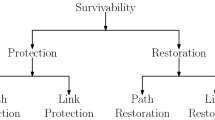Abstract
Network survivability requires the provisioning of backup resources in order to protect active traffic against any failure scenario. Backup resources, however, can remain unused most of the time while the network is not in failure condition, inducing high power consumption wastage, if fully powered on. In this paper, we highlight the power consumption wastage of the additional resources for survivability in IP/multi-protocol label switching (MPLS) over dense wavelength division multiplexing multi-layer optical networks. We assume MPLS protection switching as the failure recovery mechanism in the network, a solution interesting for current network operators to ensure fast recovery as well as fine-grained recovery treatment per label switched path. Next, we quantitatively show how elastic optical technologies can effectively reduce such a power consumption by dynamically adjusting the data rate of the transponders to the carried amount of traffic.




Similar content being viewed by others
References
Winzer, P.: Beyond 100G ethernet. IEEE Commun. Mag. 48(7), 26–30 (2010)
Autenrieth, A.: Recovery time analysis of differentiated resilience in MPLS. In: Proceedings of DRCN 2003, Oct 2003
Morea, A., Rival, O.: Efficiency gain from elastic optical networks. In: Proceedings of SPIE 8309, Optical Transmission Systems, Subsystems, and Technologies IX, Dec 2011
López Vizcaíno, J., et al.: On the energy efficiency of survivable optical transport networks with flexible-grid. In: Proceedings of ECOC 2012, Sept 2012
López, J., et al.: Traffic and power-aware protection scheme in elastic optical networks. In: Proceedings of NETWORKS 2012, Oct 2012
Morea, A., et al.: Datarate adaptation for night-time energy savings in core networks. J. Lightw. Technol. 31(5), 779–785 (2013)
Rizzelli, G., et al.: Energy efficient traffic-aware design of on–off multi-layer translucent optical networks. Comput. Netw. 56(10), 2443–2455 (2012)
Rival, O., Morea, A.: Cost-efficiency of mixed 10–40-100Gb/s networks and elastic optical networks. In: Proceedings of OFC 2011, Mar 2011
Woodward, S.L., et al.: Intra-node contention in a dynamic, colorless, non-directional ROADM. In: Proceeings of OFC 2010, Mar 2010
Ruiz, M., et al.: Survivable IP/MPLS-over-WSON multilayer network optimization. J. Opt. Commun. Netw. 3(8), 629–640 (2011)
Rambach, F., et al.: A multilayer cost model for metro/core networks. J. Opt. Commun. Netw. 5(3), 210–225 (2013)
Acknowledgments
This work has been funded by the Spanish project ELASTIC (TEC2011-27310) and the FP-7 IDEALIST project under Grant Agreement Number 317999. Moreover, the authors thank the GreenTouch consortium (http://www.greentouch.org/).
Author information
Authors and Affiliations
Corresponding author
Rights and permissions
About this article
Cite this article
Perelló, J., Morea, A., Spadaro, S. et al. Power consumption reduction through elastic data rate adaptation in survivable multi-layer optical networks. Photon Netw Commun 28, 276–286 (2014). https://doi.org/10.1007/s11107-014-0450-6
Received:
Accepted:
Published:
Issue Date:
DOI: https://doi.org/10.1007/s11107-014-0450-6




